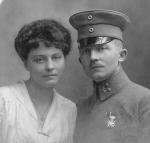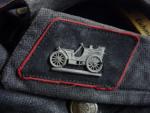-
Posts
2,962 -
Joined
-
Last visited
Content Type
Profiles
Forums
Blogs
Gallery
Events
Store
Everything posted by Chip
-
Maybe not the most valuable, but my first choice would be a Bergm?tze from one of the mountain units, the Ski battalions, the W?rttemberg Mountain Rgt., etc. Like many, I am really attracted to these elite units that fought under such difficult conditions. Second choice (I know, you only asked for a first choice) would be a khaki Tropenhelm, either from the III.See Batl. or the Asienkorps. Just a simple, but beautiful piece of headgear in my opinion. All well beyond my means now, but can't a guy can dream? Chip
-
Thanks for the reply Rick. I could not see the red ribbon in the photo, so I thought for some strange reason it was pinned on in that position. So, this doctor is wearing an EKII and a White Falcon with swords. It seems that he has done something other than work in a hospital far behind the lines. It would be very interesting to know where he served. I have seen priests with black/white EKIIs, so I guess it would not be surprising that a doctor would have either of these two awards? Chip
-

EK 1914 Help with unit id on an EK2 Certificate please
Chip replied to andy's topic in Germany: All Eras: The Iron Cross
Divisional level telephone detachment of the 233.Division. On the date given, the division was in training, away from the front, so the actual event that caused its award probably happened earlier. Chip -

Imperial pilot items
Chip replied to dante's topic in Germany: Imperial Uniforms, Headwear, Insignia & Personal Equipment
dante, Pilot's watch? What makes this a pilot's watch? It looks like a typical period wristwatch to me. It looks like a pocket watch in a wrist carrier. This was a common way of wearing this watch during the war. I have a picture of it being worn by an Austrian alpine infantryman and have seen many others photos of regular soldiers wearing it. Best regards, Chip -

Imperial pilot items
Chip replied to dante's topic in Germany: Imperial Uniforms, Headwear, Insignia & Personal Equipment
Paul, The young man in the photo does not appear to have any relation to anything having to do with flight. First, he is a Gemeine, a basic recruit. That eliminates any chance of him flying. Secondly, if the uniform was related to flight, he would have Litzen on his collar. If there is a relationship, you cannot tell it from the photo. The two cases are quite nice. Chip -

Any Idea what this is?
Chip replied to Naxos's topic in Germany: Imperial Uniforms, Headwear, Insignia & Personal Equipment
Hardy, Well, not really. I think that this Wimpel came just with the cross. I don't recall ever seeing one with a number. Chip -

Any Idea what this is?
Chip replied to Naxos's topic in Germany: Imperial Uniforms, Headwear, Insignia & Personal Equipment
Hardy, Yes, it's a navy piece, which I believe could be from the imperial through the WWII period. Chip -
Bob, I have been reading your posts on various forums for the past few years and feel like have a bit of a grasp on the type of soldier you father was. I recently read "Education before Verdun" by Arnold Zweig. The book is a contemporary of "All Quiet on the Western Front" and quite famous in its own right. One of the main characters is a "Sapper" officer and though he is a Bavarian, he strikes me as the same sort of soldier your father seems to have been. If you have not read it (it was translated into English in the 1930s), I highly recommend it. This Leutnant had been wounded several times and had come to grips with the war and actually may have "enjoyed" his part, as so many others who, when the war ended, had been so seduced by it that they had a hard time adjusting to civilian life and continued to fight in a Freikorps unit. It's a great book. Chip
-
Bob, Cutting and pasting are OK if you want to use the umlaut letters, but I prefer to use ASCII text. It is an alternate set of characters that can be used from any computer and the ASCII code is universal and can be read by any other computer. To acquire the needed letter, you just hold down the Alt key and put in the appropriate code. For instance, if you hold down the Alt ket while typing 0252, when you let up you get ?, code 0228 = ?, 0246 = ?, 0223 = ?, etc. If you do a search for ASCII codes you can, with a little searching, find a key that would give you just about anything you would want. These few letters that I have given are what I use 90% of the time. I have them memorized, so it takes only a second to insert them. The capital versions of these letters are also available and have their own codes. Garniture numerals (Roman numeral 1's) were used by the military as a rating system to mark clothing articles as to their condition and thus, wear status. For instance, a Garniture marking of "I" meant that the article was in "like new" condition and was suitable for dress or church service wear. The thrifty German military reissued garments until they were worn out or unservicable. Each time the piece was reissued, it would be inspected and a new rating assessed. There were at least five levels of condition and every time the piece was downgraded, another "I" woud be added. So, it would be conceivable to find an article with a "IIIII" marking or any number of "I"s up to five. This coding was supplanted by a new "abbreviation" type code in 1916. Chip
-

Falkenhayn
Chip replied to Snoopy's topic in Germany: Imperial Uniforms, Headwear, Insignia & Personal Equipment
snoop. Though I have not seen this particular badge before, it is in the style of the Austrian Kappenabzeichen. It may well be of Austrian manufacture, as they did make badges that commemorated their various associations with the Germans on the Eastern Front. Most Austrian made badges are maker marked on the reverse. There were some German made badges, most of which were Bavarian. The Bavarians who served on the Eastern Front with the Austrians picked up the habit of wearing these badges and I have photos of them wearing Austrian corps badges as well as German made divisional badges. Given that Rumania was a joint theater of operations, I would guess this badge is of Austrian manufacture. Chip -
Nice photos Christophe. You can almost always tell when a photo is taken in the forward trenches, because the gas masks are usually present. Only one of your photos shows a gasmask (the smallest photo). Not too many cameras were taken into the hot zones. You might have to leave it behind in a rush and who had time for picture taking there anyway? Chip
-
Tony, Well, Jeff's book is an excellent reference, but you must remember that these rules are for marking weapons. Weapons were not marked with Garniture numbers as clothing items were. First of all, nearly all weapons were marked during the prewar period. Most buckles, on the other hand, were not marked (with the exception of the saxon units). I can count on my fingers the number of unit marked Prussian belt buckles that I have seen over the past 46 years of collecting. There is no such thing as a Garde infantry regiment in the rolls of unit names. They all had something else in their name to differentiate them from other Garde regiments, like, "zu Fu?", "Garde Grenadier", "Garde Fusilier". Individual uniform items had different abbreviations and that is why I think your marking if for the Grenadier Rgt. Nr.5. Can I prove I'm right.....no I can't. Garniture numbers were Roman numerals, not Arabic numbers. There is noting else that I can think of that this numeral could be. It's not a corps or battalion number, as neither match the regiment. I have seen Garniture numerals on other belt buckles that were unit marked. Chip
-

German Pouch
Chip replied to Chris Boonzaier's topic in Germany: Imperial Uniforms, Headwear, Insignia & Personal Equipment
Chris, It's a Bulgarian ammo pouch for the Mannlicher. I have a pair of them. I think the Germans must have made all of their ammo pouches. Both of mine are German made, but also have the Bulgarian lion emblem as well. Chip -
Rick, Thanks for the info. Hopefully, the photo will have more information on the back. Just the fact that it has the date is encouraging. Here is the photo from the internet offering. It was too small to make out the medal, but the collar insignia was very clear. I will scan and post it along with any additional information when it arrives. Chip
-
I have a nice studio photo coming in about two weeks that shows a Landsturm doctor (Landsturmpflichtiger Arzt in Stabsarztstelle) wearing a white falcon with swords. It appears to be the only medal he is wearing. I do not know if there is more information on the back of the photo, though it is dated October of 1918. Is this enough information for a possible ID? I can't imagine that there would be that many Landsturm doctors awarded the white falcon with swords. Chip
-
Robert, Goggles could be worn by any soldier, depending on their duties. For instance, infantry that are trained for mountainous regions were often issued with Sonnenbrille. The goggles in your photo do not appeare to be tinted, so they are probably just wind goggles. I am not sure what type of unit this man would have been in, though I suspect the visored cap would indicate that he is not in a front line unit. Chip





